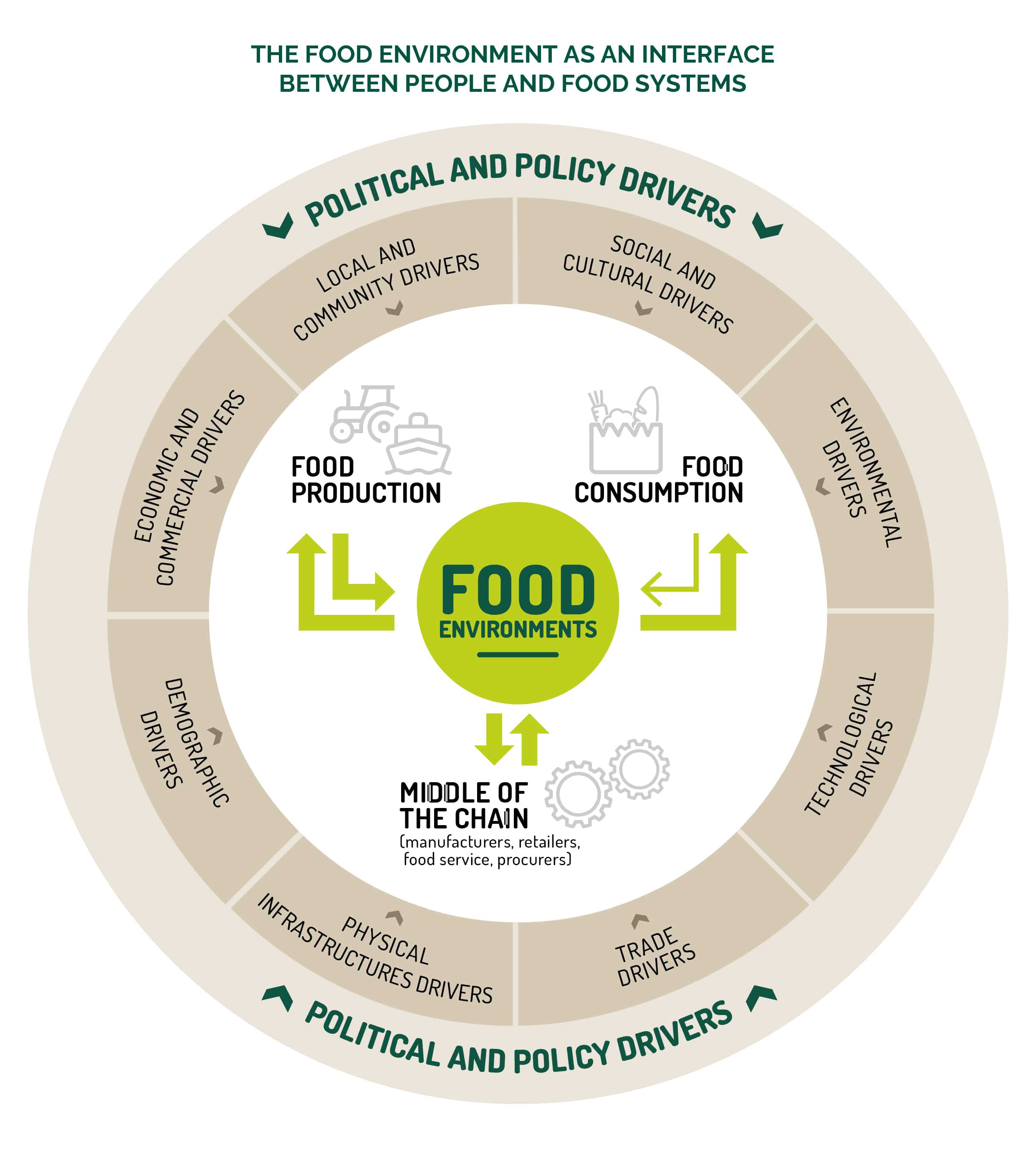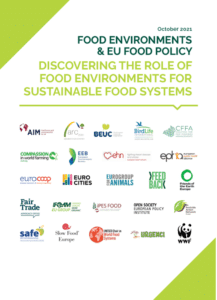‘Food environments’ are increasingly central to the food systems debate. The concept has been adopted by a range of leading organisations and incorporated in a number of initiatives, including the EU Farm to Fork Strategy. But what are food environments? What added value does the concept of ‘food environment’ bring to efforts to transition to sustainable food systems? And how do you change food environments for the better?
This policy brief, written in framework of the EU Food Policy Coalition, describes the central role that food environments play in shaping food consumption and their potential to leverage a healthy food systems transformation. It presents a vision for enabling food environments, supported by 24 civil society organisations. The briefing calls on public authorities to step-up their role and identifies seven areas for action.
A joint vision for enabling food environments
Creating enabling food environments means ensuring that foods, beverages and meals that contribute to sustainable healthy diets are the most available, accessible, affordable, pleasurable and widely promoted.
Such environments make the healthy and sustainable choice the default and most desirable choice, while limiting the availability and promotional opportunities for foods associated with unhealthy and unsustainable diets.
Sustainable food environments, furthermore, drive demand for socially just supply chains and production models that work with nature, rather than against it, that are climate-proof, and that take high levels of animal welfare as their starting point.
What are food environments?
The food environment, in a widely used definition, refers to the “physical, economic, political and socio-cultural context in which consumers engage with the food system to make their decisions about acquiring, preparing and consuming food.” (HLPE, 2017)
Other definitions include:
“The food environment is the interface that mediates people’s food acquisition and consumption within the wider food system. It encompasses external dimensions such as the availability, prices, vendor and product properties, and promotional information; and personal dimensions such as the accessibility, affordability, convenience and desirability of food sources and products” (European Commission, Group of Chief Scientific Advisors, 2020)
“The collective physical, economic, policy and sociocultural surroundings, opportunities and conditions that influence people’s food and beverage choices and nutritional status.” (INFORMAS: Swinburn et al., 2013)
The food environment is a combination of:
1. Food chain dynamics, particularly referring to:
A – ‘Food entry points’, or the settings in which foods are made available and purchased, such as supermarkets, neighbourhood shops, local markets, digital apps, direct farm sales, canteens, schools, (fast food) restaurants, street food stalls, social dining places, etc.
B – The foods, beverages and meals themselves that are made available, and are accessible, affordable and desirable as people go about their everyday lives.
2. Aspects of the built environment that affect access to food entry points, including the distance to food outlets, the availability of physical infrastructures to access such entry points, such as public transport networks, etc.
3. Personal characteristics that influence food choices, including levels of income and education, attitudes, cultural values, skills, etc.
4. The political, social, economic and cultural contexts in which the above aspects are embedded.

A people-centric view of food environments
From a person-centric, ‘lived experience‘ perspective, food environments can be seen as the spaces in which people make decisions about food: what to take, where to buy it, where to cook it, and when, where and with whom to eat it.
These spaces intimately shape what food we buy and eat.
The problem is that “today’s food environments exploit people’s biological, psychological, social, and economic vulnerabilities, making it easier for them to eat unhealthy foods. This reinforces preferences and demands for foods of poor nutritional quality, furthering the unhealthy food environments.” (The Lancet, Obesity, 2015)

Food environment: a key point for policy intervention
Food environments create key common spaces in which food decisions are taken. This underlines their importance as strategic points of intervention.
Food environments are, to a significant degree, commercially determined, especially by actors in the ‘middle’ of the food chain. Such actors include retailers, manufacturers, food service companies (e.g. restaurants, fast food chains, catering services), advertisers and other economic operators (e.g. delivery services), but also public procurers. A focus should therefore be placed on these actors when designing strategies for reshaping food environments.

Creating enabling food environments with regulatory policies in the driving seat
Creating enabling food environments is not a question of acting ‘bottom-up’ vs ‘top-down’, rather, it is about creating a multi-layered ‘ecosystem’ of mutually supportive policies and activities.
Binding policies, such as regulation and fiscal measures, tend to be the most effective interventions and must be the main drivers of change to healthy and sustainable food systems operating within planetary boundaries. Voluntary commitments and self-regulatory initiatives should only be seen as complementary drivers and never replace regulation.

Image copyright: This is an open-access publication distributed under the terms of the Creative Commons Attribution License (CC BY-NC-SA 4.0). The non-commercial use, distribution or reproduction of images in other forums is permitted, provided the original paper is referred to. No use, distribution or reproduction is permitted which does not comply with these terms.
Citation suggestion: Policy briefing. Food Environments & EU Food Policy. Discovering the role of food environments for sustainable food systems (2021) EU Food Policy Coalition
The dimensions of an enabling food environment
Illustration credit: irisistibledesign.com
Illustration copyright: This is an open-access illustration distributed under the terms of the Creative Commons Attribution License (CC BY-NC-SA 4.0). The non-commercial use, distribution or reproduction of images in other forums is permitted, provided the source (EPHA) is referred to. No use, distribution or reproduction is permitted which does not comply with these terms.


